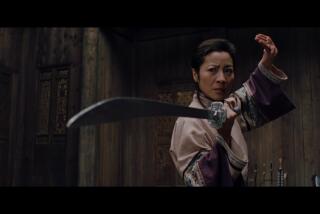MOVIE REVIEW : ‘The Last Emperor’ Takes a Lavish Look at Decadent Life
- Share via
In 1908, on the whim of the Empress Dowager dying under her cracking whitewash makeup, a beguiling 3-year-old is torn away from his mother in the dark of night and taken, with his wet nurse, to China’s most astonishing palace--the 9,999-room Forbidden City. There, robed in imperial yellow and placed on a Dragon Throne, tiny Pu Yi becomes 10th Quing Emperor, ruler of nearly half the world’s people.
And so begins the life of “The Last Emperor” (Cineplex Odeon Century City), as coolly lavish an epic as we may ever see. Giving free rein to the cinema’s most voluptuous troika of imagists--director Bernardo Bertolucci (“1900,” “Last Tango in Paris”), production designer Ferdinando Scarfiotti (“The Conformist,” “American Gigolo,” “Scarface”) and cinematographer Vittorio Storaro (“Reds,” “Apocalypse Now”)--has resulted in an intoxicating visual rush.
Whether it is the sight of the boy, unself-consciously unweaned at the age of 8, availing himself of his beautiful wet nurse while his dowager aunts spy in horror, or of three prisoners wandering the palace courtyard in a triple wooden neck stock, “The Last Emperor” seems destined for the Great Moments Collection of the mind’s eye.
Yet its core is cool and distant: the story of a man history ill-fitted for life at either end of a telescope lens--as a “living god” at 4, or as the living set piece of Maoist “remolding” at 42.
It’s supposed to be a story of inner peace through ideological retraining, a fairy-tale story with a Maoist twist, intoxicatingly lavish on the one hand, primly doctrinaire on the other--just the qualities that have piqued Bertolucci’s sensibilities in the past (“The Conformist,” “1900”).
The sensualist, however, seems to have gotten the upper hand over the ideologue: the sense of Pu Yi’s peace and joy after his release into modern China in 1960, with the title “citizen,” is lost somewhere. The remolded man casts almost no shadow, even less than the impassive emperor. Bertolucci believes that his late introduction to humanity “took.” Based on the film’s evidence alone, his audiences may not be so sure.
But even though the indoctrination scenes are strengthened by the formidable Ying Ruocheng (a noted actor as well as the current Chinese deputy minister of culture) as the governor of Fushun Prison, no one would blame audiences who preferred the movie’s moments of divine decadence. The film is glutted with them: the Empress Dowager’s death scene as her bed moves mysteriously toward the wide-eyed 3-year-old Pu Yi; or a bedroom scene of three-way hanky-panky under billowing silken sheets, or a nuptial night, all in reds and golds, in which the 15-year-old emperor and his aristocratic young wife are undressed by unseen hands--a trick Bertolucci borrows from Chinese theater and its “invisible” property men.
Mark Peploe (“The Passenger”), credited along with Bertolucci for the screenplay, has a staggering amount of history to compress, even with the film’s hefty 2 3/4-hour running time. He tries only fitfully, concentrating primarily on the true melodrama of Pu Yi’s life.
The movie is framed within his “reeducation” period in Fushun in 1950, a cannily ironic move: The emperor’s flashbacks to his decadent past become part of what he must confess and/or atone for. They comprise some of the most mind-boggling Cliff Notes to Chinese history imaginable. Pu Yi’s reign was over before he was 6, although he remained cloistered within the Forbidden City’s labyrinthine tomato-colored walls for 16 years. (Pu Yi at the ages of 3, 8 and 15 is played by three different youngsters. It’s the 15-year-old, Wu Tao, who uncannily resembles the mesmerizing John Lone, perfectly cast as the emotionally distant adult emperor.) Pu Yi was educated primarily by “R.J.,” Sir Reginald Johnston (a wonderfully dry but patient Peter O’Toole). The emperor was wed to one wife (Joan Chen) and had one chief consort (Wu Jun Mei); he was treated like a true “Lord of Ten Thousand Years,” and he was allowed any excess--except to live in the present or to set foot outside the palace.
That would not happen until 1924, when a republican warlord captured Peking. Summarily, the 18-year-old ex-emperor was thrust into the outside world. For a while, flanked by both beautiful wives, he tried life as a playboy in Tientsin (Bertolucci stages this deliciously, as Lone croons “Am I Blue” to a nightclub full of lounge lizards). Later, fatefully, he accepted the seductive invitation of the Japanese to become emperor of the new state of Manchukuo. It was this move which branded him as a political criminal at the end of World War II, quarry for both the Russians and the new, Maoist Chinese.
Although the real characters of Pu Yi’s life were more astonishing than even this screenplay suggests, the movie goes into melodramatic overdrive with the Manchukuo period. It’s a heady excess--featuring a beautiful leather-suited aviatrix-spy, Eastern Jewel (Maggie Han), and such diversions as bisexual adultery, ennui, opium addiction, suicide and infanticide--and it comes at us from every direction at once. (Nothing, however, can ruin Joan Chen’s last moments as the addicted empress.)
But even this section has its visual rewards, like the Industrial Moderne murals in Pu Yi’s offices; the scene in the escape plane as the Russian parachutists arrive, or the charming little fillip with which Bertolucci ends the film--the best vanishing trick of all. If you want the true, jaw-dropping details of Pu Yi’s life, try the biography by Edward Behr, Newsweek International’s cultural editor. If you want a staggering and certainly singular movie experience, “The Last Emperor” (MPAA-rated: PG-13 for brief nudity, bloodshed) will do very nicely.
More to Read
Only good movies
Get the Indie Focus newsletter, Mark Olsen's weekly guide to the world of cinema.
You may occasionally receive promotional content from the Los Angeles Times.










